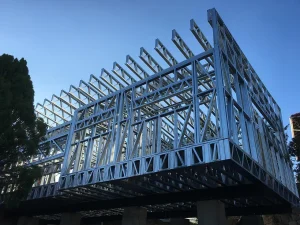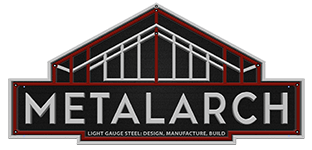 Light Gauge Steel: The Answer to the Ongoing Housing Shortage
Light Gauge Steel: The Answer to the Ongoing Housing Shortage
In recent years, the construction industry has faced significant challenges due to escalating costs and supply constraints associated with timber-framed housing, commonly known as “stick builds”. Recent political factors, such as international trade disputes and environmental concerns, have further emphasized the need for builders and developers to seek alternative materials as the industry struggles to address a nearly five-million-unit shortfall. With the timber industry on the verge of collapse and housing stagnating, cold formed light gauge steel framing (“LGS”) has quietly emerged as a clear solution to the national housing crisis.
What is LGS Framing?
When most people think of metal framing, they often imagine large steel I-beams used in skyscrapers or the flimsy wall studs found at local hardware stores. However, LGS cold-rolled framing is entirely different. Far more economical and versatile than traditional steel systems, Metalarch LLC (Peachtree Corners, GA), is proving to be an industry disruptor with their “Snap & Screw” steel framing systems. Unlike conventional stick builds, which consist of individual materials components that must be cut, drilled, nailed, strapped, and welded in the field, LGS transforms the building process by producing pre-cut, pre-drilled, and pre-formed components which are ready to assemble onsite.
The process begins by converting traditional two-dimensional blueprints into three-dimensional Building Information Modeling (BIM) files. These digital files are then loaded into advanced roll-forming machines, which use large coils of galvanized sheet metal to bend, punch, dimple, drill, and cut each component with an accuracy of one thirty-second of an inch. The individual pieces are then assembled into panels in the factory, creating walls, roofs, and trusses that can be quickly fastened together on-site using common drills and sheet metal screws. This eliminates the need for measuring and cutting while significantly reducing waste. As a result, builds are completed 60–75% faster, cost 10–15% less, and far superior to wood-framed units.
Ultimately, LGS systems simplify construction to the point where homeowners with nothing more than a pair of drills can erect their own structures in hours rather than weeks. This also benefits the labor market as workers can become highly proficient with the snap-and-screw system within days, whereas achieving the same expertise in wood framing takes years.
Cost Efficiency and Economic Advantages
Despite its advantages, LGS remains underutilized, raising the question: why has this method not been widely adopted? Historically, LGS systems have been overlooked due to the misconception that steel is significantly more expensive than wood. While this may have been true for traditional steel systems which require welding and heavy lifting equipment, LGS presents a different reality because it is both light and ready to assemble.
Another barrier to steel adoption is the reluctance of builders and developers to change. Innovation often brings uncertainty, making some hesitant to adopt new systems. However, commercial construction is almost exclusively steel-based. Given that these materials and methods have been proven in far more complex buildings, integrating them into the residential market should be a natural transition.
For a simple comparison, let’s consider a 2,300-square-foot home (the national average). Stick builds typically require over seven days for framing and an additional 175 days for finishing. In contrast, Metalarch’s Snap N Screw LGS system reduces those timeframes to just two days for framing and 100 days for finishing. Further supporting the case for steel, the total cost to build the same home using stick framing is $275,000, whereas steel construction reduces this cost to $248,000. Additionally, steel’s resistance to fire, warping, rotting, and pest infestation, along with its dimensional stability, results in insurance premiums that are 17–28% lower for the lifetime of the home. The result is a quicker build with a lower upfront cost and lower carrying costs.
Environmental Considerations: Sustainability and Recyclability
LGS systems are significantly more environmentally friendly than timber, as steel’s superior performance minimizes its environmental impact throughout its entire life cycle. Traditionally the wood industry has tried to maintain the pretense that timber framing is “carbon neutral”, however, nothing could be further from the truth. From the costs of harvesting and processing, to the increase in carbon emissions produced during decay, the idea of carbon neutrality through deforestation is patently false. On the other hand, steel is known to have a higher “initial” carbon output during steel manufacturing, but makes up for that initial spike with key sustainability factors over its entire life span. Several key factors include:
- Recyclability: Steel is infinitely recyclable, allowing materials to be reused indefinitely without degradation. This reduces the demand for virgin resources and minimizes waste.
- Resource Abundance: Steel is produced from abundant raw materials and can be scaled up or down within months to meet market demands. In contrast, wood requires 10–20 years to grow and takes even longer to recover from natural disasters or market fluctuations.
- Reduced Deforestation: Choosing steel framing decreases the demand for timber, helping to preserve forests and biodiversity.
- Reduced Emissions: The carbon stored in wood construction products represents only a fraction of the carbon in the trees they originate from. Over time, that carbon is released back into the atmosphere through decay or incineration.
To put it simply, an average single-family home can either costs the environment 122 mature trees, or facilitate the removal of six abandoned cars from landfills. Which would you prefer for the future of the environment? In choosing steel, builders contribute to more sustainable construction practices that align with environmental conservation efforts.
Impact of Recent Timber Tariffs and Sanctions
The timber industry has been significantly affected by recent natural disasters and international trade policies. In August 2024, the United States increased tariff rates on Canadian softwood lumber imports from 8.05% to 14.54%, exacerbating supply shortages and driving up domestic timber prices. More recently, in March 2025, the U.S. administration initiated a Section 232 investigation into timber and lumber imports, raising the possibility of additional 25% tariffs and further sanctions. These developments have created uncertainty in the timber market, making light gauge steel an increasingly attractive and stable alternative.
While foreign steel has also faced tariffs, the domestic steel industry has absorbed these impacts through increased production and strategic stockpiling. This has helped stabilize prices, and in many cases, steel pricing can be locked in for up to 12 months, ensuring builders and developers are not exposed to sudden fluctuations. As a result, steel is the more attractive option for planning and budgeting future projects.
Steel is Future-Proof
Light gauge steel framing addresses nearly all the challenges associated with timber construction. Its cost efficiency, superior durability, favorable insurance implications, environmental benefits, and insulation from volatile timber markets make it a compelling choice for modern construction needs. The only question left is how quickly the industry will embrace this change and begin to take advantage of this superior building technique.

